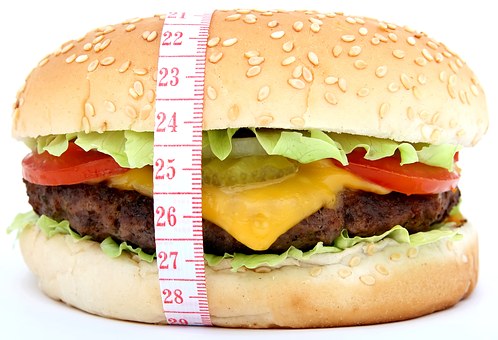… Or does it?
Headlines like this grab your attention, don’t they? Unfortunately, they are often misleading and misinterpret associated research.
Today I’ll take you through a recent nutrition study, to show you some things to look out for!
The Study
Compelling evidence already independently links one’s exposure to fast food(1-3) and lower socioeconomic status (SES) (4-6) with increased risk of obesity. Researchers in Cambridge, United Kingdom (UK), wanted to understand the interaction between these two factors and published the results of their study earlier this year, “Does neighborhood fast-food outlet exposure amplify inequalities in diet and obesity? A cross-sectional study.”(7).
How did they do this?
Researchers gathered survey data and BMI measurements on 5958 adults in Cambridgeshire , UK. Provided information included level of education, living and work locations and regular food consumption habits. Local councils provided data on fast-food outlet locations which was used to determine a person’s outlet exposure.
, UK. Provided information included level of education, living and work locations and regular food consumption habits. Local councils provided data on fast-food outlet locations which was used to determine a person’s outlet exposure.
What did the researchers discover?
Some compelling trends were found. While Figure 1 looks a little technical, it means this:
- People that are exposed to more fast food outlets consume more fast food.
But most importantly for the researchers’ objective, it shows:
- Despite a person’s outlet exposure, if they are more educated, they consume less fast-food. Conversely, those with lower education were more vulnerable to outlet exposure.
This trend was almost identical for BMI (read the full report if you’re interested).

Figure 1. Mean (95% CI) fast-food consumption per quartile of combined home and work fast-food outlet exposure in the Fenland Study sample (n = 6123) (A), and stratified by educational attainment (B) (1)
To the untrained eye, this seems like it’s a done deal!
However, several things need to be considered when reading any study to understand how applicable the results are to yourself and the community.
1. Type of Study
The study in question is a a type of Observational Study(8) called a Descriptive Cross-Sectional Study(8-10). The measurement of cause and effect happens at one point in time (8-10). The researchers indeed identified this limitation themselves.
In order to be able to say that ‘X’ causes ‘Y’ outcomes must be measured over time and compared between exposed and non-exposed groups (8, 10) like in interventions or randomised controlled trials (RCTs)(10-13).
But cross-sectional studies CAN show that an association MAY exist, measure rates or prevalence of diseases and be used to direct further research (8, 10, 14).
2. Other factors may have influenced the results.
Some factors, aside from those being studied, known as “confounders”(7, 8, 10) may also affect obesity risk (eg. age, gender, activity level, smoking status and income(7)). In this study, the statisticians have adjusted the data accounting for such factors(7).
However, some aspects could not be accounted for (7), like:
- Only home and work exposures were measured, not other environments, like commuting.
- How long had the person been living/working in that location? Perhaps recent relocations affected survey answers.
- Participants resided in Cambridgeshire, UK, an area with higher education level and less ethnic diversity compared to elsewhere in the UK, on average(7).
Such factors affect who the results can be applied to, Would it apply to, say, the residents of Delhi, India?
3. How meaningful are the results?
 To be relevant, results of any study must be meaningful, or “statistically significant” (8, 15, 16). Technical-sounding things like “confidence intervals”, “p-values” and “correlation” help researchers determine whether a difference between groups is really meaningful, or just due to chance(15, 16).
To be relevant, results of any study must be meaningful, or “statistically significant” (8, 15, 16). Technical-sounding things like “confidence intervals”, “p-values” and “correlation” help researchers determine whether a difference between groups is really meaningful, or just due to chance(15, 16).
Researchers found a significant difference between obesity risk in lowest and highest educated participants, but not between middle and lowest level education participants (7).
4. What do other studies say?
Results must be looked at within the broader spectrum of available evidence (11, 12, 14, 17). Several interventions or RCTs are usually required to confirm that X causes Y (14, 17-19).
The researchers recognised this is the first to assess combined interaction, thus further research is needed to refine the conclusions.
What do the results mean for the community?
 For the first time, this study demonstrated the COMBINED effects of education (SES) and outlet exposure on fast food consumption and obesity. It contributes to existing literature on the topics, providing a good starting point for further research.
For the first time, this study demonstrated the COMBINED effects of education (SES) and outlet exposure on fast food consumption and obesity. It contributes to existing literature on the topics, providing a good starting point for further research.
The outcomes of this study (along with the greater body of evidence) suggest that regulation of fast-food outlets – seen in the UK(20) and Los Angeles(21) – MIGHT help to improve diet (and thus, health). Governments can use it to develop public health and education policies. It may even ignite movements by non-government groups.
I also recorded this video about the study!
References
1. French SA, Harnack L, Jeffery RW. Fast food restaurant use among women in the Pound of Prevention study: dietary, behavioral and demographic correlates. International Journal of Obesity & Related Metabolic Disorders. 2000;24(10).
2. Pereira MA, Kartashov AI, Ebbeling CB, Van Horn L, Slattery ML, Jacobs DR, et al. Fast-food habits, weight gain, and insulin resistance (the CARDIA study): 15-year prospective analysis. The lancet. 2005;365(9453):36-42.
3. Viner RM, Cole TJ. Who changes body mass between adolescence and adulthood? Factors predicting change in BMI between 16 year and 30 years in the 1970 British Birth Cohort. International journal of obesity. 2006;30(9):1368-74.
4. Thornton LE, Bentley RJ, Kavanagh AM. Individual and area-level socioeconomic associations with fast food purchasing. Journal of epidemiology and community health. 2011;65(10):873-80.
5. Miura K, Giskes K, Turrell G. Socio-economic differences in takeaway food consumption among adults. Public health nutrition. 2012;15(02):218-26.
6. Miura K, Turrell G. Reported consumption of takeaway food and its contribution to socioeconomic inequalities in body mass index. Appetite. 2014;74:116-24.
7. Burgoine T, Forouhi NG, Griffin SJ, Brage S, Wareham NJ, Monsivais P. Does neighborhood fast-food outlet exposure amplify inequalities in diet and obesity? A cross-sectional study. The American journal of clinical nutrition. 2016;103(6):1540-7.
8. Liamputtong P. Research Methods in Health : Foundations for Evidence Based Practice. Melbourne: Oxford University Press; 2013. Available from: http://deakin.eblib.com.au/patron/FullRecord.aspx?p=1986006.
9. Polgar Sa, Thomas SAa. Introduction to research in the health sciences: Edinburgh : Churchill Livingstone/Elsevier, 2013. Sixth edition.; 2013.
10. Booth A. HSN715 Understanding Human Nutrition Research Studies. Module 3. Melbourne, Australia: Faculty of Health, Deakin University; 2016.
11. Daly J, Willis K, Small R, Green J, Welch N, Kealy M, et al. A hierarchy of evidence for assessing qualitative health research. Journal of clinical epidemiology. 2007;60(1):43-9.
12. Russo F, Williamson J. Interpreting Causality in the Health Sciences. International Studies in the Philosophy of Science. 2007;21(2):157-70.
13. Polgar S, Thomas SA. Introduction to Research in the Health Sciences. London: Elsevier Health Sciences UK; 2013. Available from: http://deakin.eblib.com.au/patron/FullRecord.aspx?p=1746284.
14. Hayward RS, Wilson MC, Tunis SR, Bass EB, Guyatt G. Users’ Guides to the Medical Literature: VIII. How to Use Clinical Practice Guidelines A. Are the Recommendations Valid? Jama. 1995;274(7):570-4.
15. Peat JK, Williams K, Xuan W, Wei Xuan. Health Science Research : A handbook of quantitative methods. Sydney: Allen & Unwin; 2001. Available from: http://deakin.eblib.com.au/patron/FullRecord.aspx?p=286606.
16. Booth A. HSN715 Understanding Human Nutrition Research Studies. Module 4. Melbourne, Australia: Faculty of Health, Deakin University; 2016.
17. Caldwell K, Henshaw L, Taylor G. Developing a framework for critiquing health research. Journal of Health, Social and Environmental Issues. 2005;6(1):45-54.
18. Popay J, Rogers A, Williams G. Rationale and standards for the systematic review of qualitative literature in health services research. Qualitative health research. 1998;8(3):341-51.
19. Stroup DF, Berlin JA, Morton SC, Olkin I, Williamson GD, Rennie D, et al. Meta-analysis of observational studies in epidemiology: a proposal for reporting. Jama. 2000;283(15):2008-12.
20. Burgoine T, Forouhi NG, Griffin SJ, Wareham NJ, Monsivais P. Associations between exposure to takeaway food outlets, takeaway food consumption, and body weight in Cambridgeshire, UK: population based, cross sectional study. BMJ (Clinical research ed). 2014;348:g1464.
21. Council LAC. FAST FOOD RESTAURANTS / INTERIM CONTROL ORDINANCE / WEST-ADAMS-BALDWIN HILLS-LEIMERT, SOUTH AND SOUTHEAST LOS ANGELES. In: Clerk OotC, editor. Los Angeles, USA2008.

